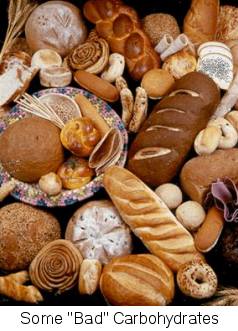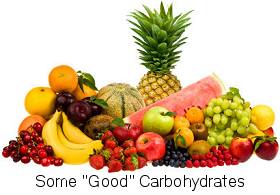Carbohydrates, The Glycemic Index and your Weight
(Part 3 - How Carbohydrates and The Glycemic Index affect weight gain)
Carbohydrates are the energy-giving nutrients. Walking, running, working, playing sports, and even cleaning, sitting and sleeping require and use up energy. Carbohydrates (carbs for short) are the main supply of energy in our diets.
Carbs also play a major part in helping you to maintain a healthy weight. If you eat too many of the so called 'bad carbs' you can expect to gain weight and actually lose energy.
If you eat a balanced amount of "good carbs" you can expect to increase energy and not increase weight.
In fact, there are so many carbs available now on the market, that there is now a classification system in place to help us identify the good carbs from the bad carbs and here is how it works.
Glycemic Index ( often shortened to G.I. )
The word glycemic means: "something causing glucose (a type of sugar) in the blood". The words "glycemic index" literally means a measure or indicator of the amount of glucose in the blood.
You may see on some food labels the words "'High G.I." or "Low G.I."
The G.I. stands for the "Glycemic Index" of food and it relates to the amount of time it takes the carbohydrate in the food to be broken down into glucose. Glucose is the main form of transportable energy used by the cells. The glycemic index of food measures how fast the carbs cause the blood sugar to rise.
Blood glucose level is closely related to the amount and type of carbohydrates you consume. Different carbohydrates (carbs) cause different levels of glucose in the blood.
At first glance you may think that foods high in glucose or with a high G.I. are the best. However, this isn't necessarily the case in practice.
As a way to help compare different foods with each other, scientists invented the glycemic index. The most common method is to treat glucose sugar as having the value of 100. Then all other items are compared to this value.
High Glycemic Index Foods - Those with G.I. value over 70
 Foods with a high Glycemic Index rating, (over 70), give you a very fast source of energy that usually lasts for a short time. It then crashes down just as quickly as it is has risen. This is known as an energy spike.
Foods with a high Glycemic Index rating, (over 70), give you a very fast source of energy that usually lasts for a short time. It then crashes down just as quickly as it is has risen. This is known as an energy spike.
Some of the foods in this category include things such as ice-cream, chocolate bars, cakes, biscuits and sugary drinks. It also includes a few surprises such as white bread, regular corn flakes and many other processed breakfast cereals.
You may get an initial kick of energy by eating foods in this category, but your body is eventually left wanting and to maintain this "artificial high", it demands more high sugar foods. Incidentally, it appears that excessive eating in this manner, over many months or years, can develop into Type 2 Diabetes.
Low Glycemic Index Foods - Those with G.I. value less than 55
Foods with a low G.I. rating, (55 or less) - include whole grain breakfast cereals, whole grain pasta, brown breads, many fruits, brown rice, whole foods, nuts, milk, eggs and meat.
 Foods with a low G.I. take longer to break down into glucose and will also give you a more sustainable level of energy for a longer time.
Foods with a low G.I. take longer to break down into glucose and will also give you a more sustainable level of energy for a longer time.
This means you will have less peaks and troughs in your blood sugar levels. In turn, this can also mean less mood swings and less sudden waves of tiredness.
Excess Glucose is usually converted to Fat
If we eat high G.I. foods continually, without utilising the energy they produce, the body will convert excess blood sugar into fat. This is where insulin enters the process. Insulin is a hormone produced by the pancreas that helps to regulate our blood sugar levels throughout the day and night.
Insulin removes excess blood sugar levels and converts this into glycogen, which is stored in the liver and muscles. If there is more glucose in the blood than can be stored, it will be converted into fat and can be stored anywhere, but is often most noticeable in places such as the buttocks, hips, tummy and sides.
Which Carbs are best to eat ?
Foods with a low G.I. give us a slow build up of blood sugar. They provide a more sustainable source of energy than high G. I. foods. A well-balanced diet would include some low G.I. Carbs for breakfast, ensuring you have a good supply of energy for your morning's work until lunchtime. For example, this could be 2 slices of whole grain bread or whole grain cereals with low fat milk.
Highly processed cereals, even when marketed as healthy, are often packed with sugar. These do not provide a sustainable breakfast for a morning of hard work, sports or concentrated work. It is likely you will feel hungry again during the morning or even feel a little drowsy as your blood sugar levels fluctuate too much.
Eating some protein at the start of the day helps to gradually increase blood sugar levels and maintain them at a sensible level for a longer time.
Ideally you should choose some low-fat protein sources as this can result in little excess fat being stored. Your body will usually be less stressed by snacking on protein than by snacking on sugar. You get more sustainable energy levels when you eat whole grains and protein than with a quick-fix chocolate bar.
Here's Part 4 - Healthy Diet Recipe Tips

